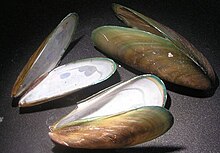| Mytilida | |
|---|---|

| |
| Three shells of Perna viridis | |
| Scientific classification | |
| Domain: | Eukaryota |
| Kingdom: | Animalia |
| Phylum: | Mollusca |
| Class: | Bivalvia |
| Subclass: | Pteriomorphia |
| Order: | Mytilida |
| Superfamilies | |
| Synonyms | |
|
Mytiloida | |
Mytilida is an order of marine bivalve molluscs, commonly known as true mussels.[1] There is one extant superfamily, the Mytiloidea, with a single extant family, the Mytilidae.
Species in the order Mytilida are found worldwide, but they are more abundant in colder seas, where they often form uninterrupted beds on rocky shores in the intertidal zone and the shallow subtidal. The subfamily Bathymodiolinae is found in deep-sea habitats.
Mytilids include the well-known edible sea mussels.
A common feature of the shells of mussels is an asymmetrical shell that has a thick, adherent periostracum. The animals attach themselves to a solid substrate using a byssus.
2010 taxonomy
[edit]In 2010, a new proposed classification system for the Bivalvia was published by Bieler, Carter & Coan. This included the suborder Mytiloida.[2]
- Superfamily †Modiolopsoidea
- Family †Colpomyidae
- Family †Modiolopsidae
- Family †Saffordiidae
- Superfamily Mytiloidea
- Family †Mysideiellidae
- Family Mytilidae
References
[edit]- ^ Mytilida Ferussac, 1822. Retrieved through: World Register of Marine Species on 9 July 2010.
- ^ Bieler, R., Carter, J.G. & Coan, E.V. (2010) Classification of Bivalve families. Pp. 113-133, in: Bouchet, P. & Rocroi, J.P. (2010), Nomenclator of Bivalve Families. Malacologia 52(2): 1-184
Well, that’s interesting to know that Psilotum nudum are known as whisk ferns. Psilotum nudum is the commoner species of the two. While the P. flaccidum is a rare species and is found in the tropical islands. Both the species are usually epiphytic in habit and grow upon tree ferns. These species may also be terrestrial and grow in humus or in the crevices of the rocks.
View the detailed Guide of Psilotum nudum: Detailed Study Of Psilotum Nudum (Whisk Fern), Classification, Anatomy, Reproduction